The 240mm Gyuto from Misono with EU steel is a knife that doesn’t do anything special but still manages to be one of my favorite knives. Figure out why in this review.
Misono EU ‘’Swedish’’ High Carbon Steel?
A quick note before we start the review of the Misono Carbon Steel knife. The Misono EU ‘’Swedish’’ Steel naming and logo have been replaced with ‘’EU Carbon’’ Steel. The ‘’Swedish’’ naming has been dropped.

Aesthetic
The Misono 240mm High Carbon EU Steel Gyuto has a simple design with no extra flair. The only noticeable design element is the dragon edging which is optional and only available on the Slicer and Gyuto with a length of 240mm or higher. It comes with a full-tang black Pakkawood handle that is held together with brass pins. The Mono-steel construction is made from European Carbon Steel, which is a non-stainless steel type.

This steel type will discolor after multiple uses which we call a patina layer which is a natural protective layer that will rust-proof your knife over time. However, you still have to reduce the exposure to moisture until you have built a strong Patina. The black color on the debossed logo and dragon will eventually fade away.

Weight of the Misono High Carbon Steel – 240mm Gyuto
With a weight of 235 grams, this Gyuto from Misono is on the heavier side compared to the traditional Japanese Gyuto. However, due to the overall design and point of balance, the knife does not feel heavy during use.
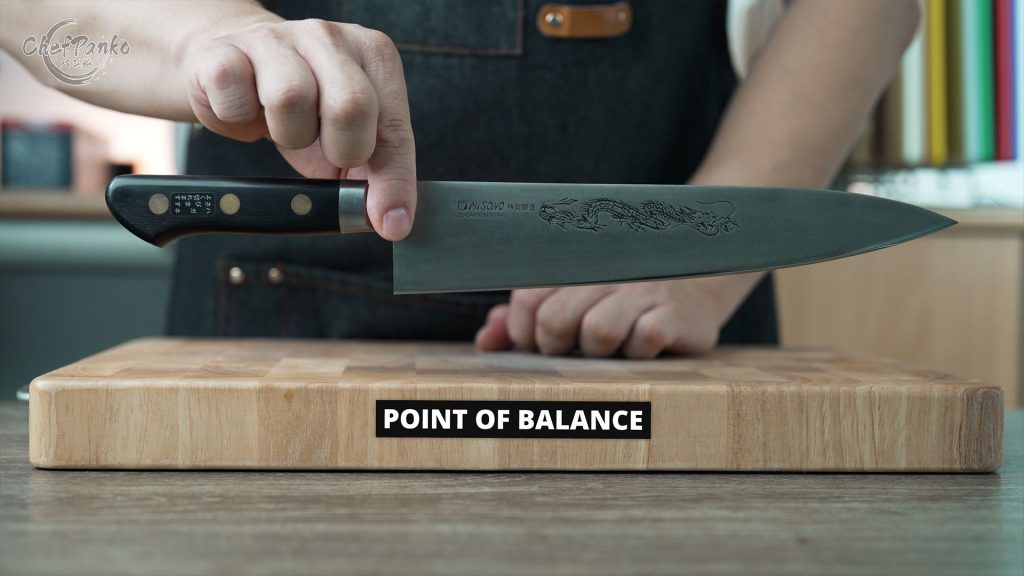
Gripping Style & Balance Point
The most comfortable grip is a pinch grip at the bolster, this gripping style at that position will make the knife middle balanced. If you switch to a fingertip grip or a handle grip the knife will become front-heavy.
Knife Handle & Comfort
The knife handle has a thickness of 18.3mm and comes with a length of 120mm. Due to the nice contours and the slight belly beneath, it is comfortable to hold. My fingers wrap around it very comfortably without losing any grip. If I switch to a fingertip grip the butt of the handle prevents you from slipping.
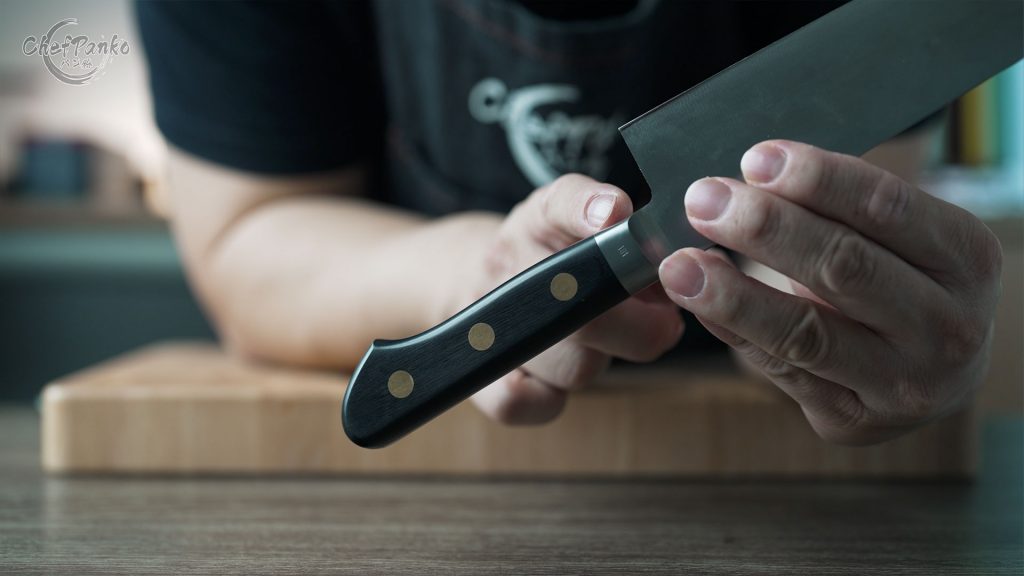
Handle Sizes
Remember that the handle size will vary depending on the knife length. The longer the knife the bigger the handle.

Handle Material
Despite the water-resistant properties of Pakkawood, it can still shrink and expand slightly due to humidity. Pakkawood will expand when it is warm and shrink when it is cold. However, the effect is minimal compared to a natural wooden handle. Therefore some Misono knives will have a slight protrusion which does not affect the knife and is not noticeable during use.
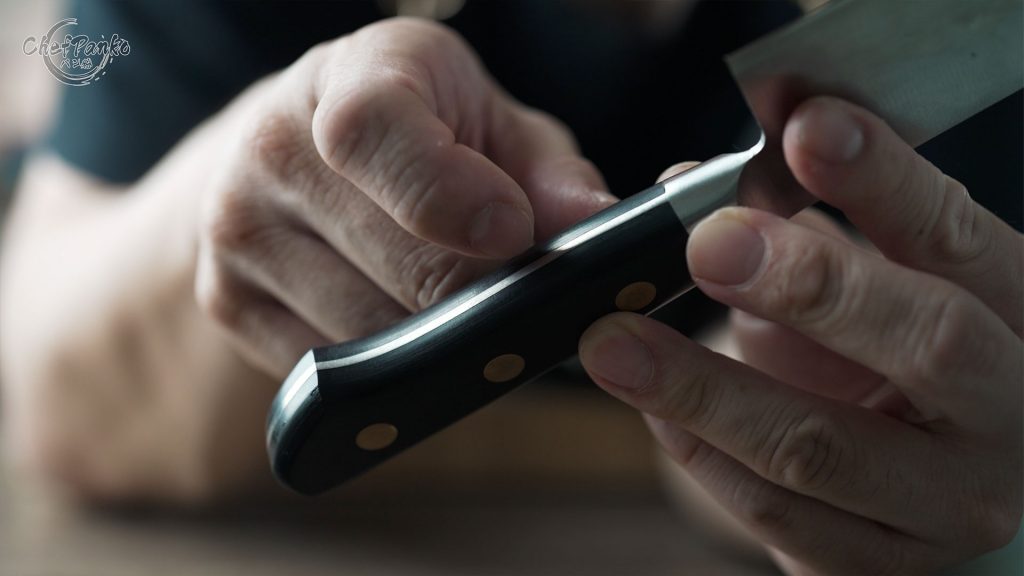
Knife Profile & Height
The blade profile is relatively flat that comes with a gentle curve that does a decent job with a push/pull cutting and chopping motion.
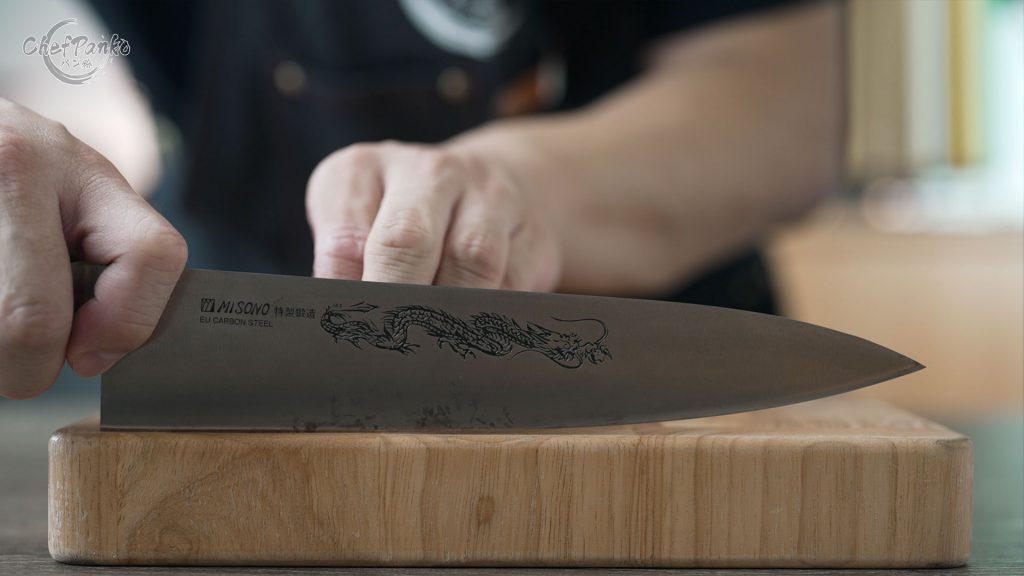
But due to the straighter profile, it is not ideal for mincing on things like herbs or garlic. The knife height is 49mm which provides a decent knuckle clearance.
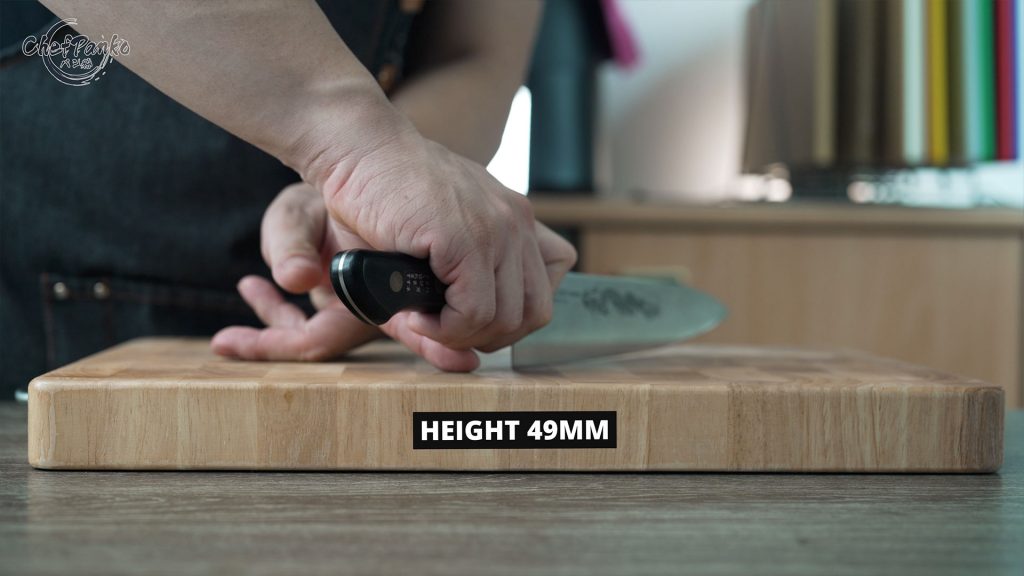
Sharpness & Edge Retention
It comes with a fine edge and a 70/30 bevel for increased cutting performance.
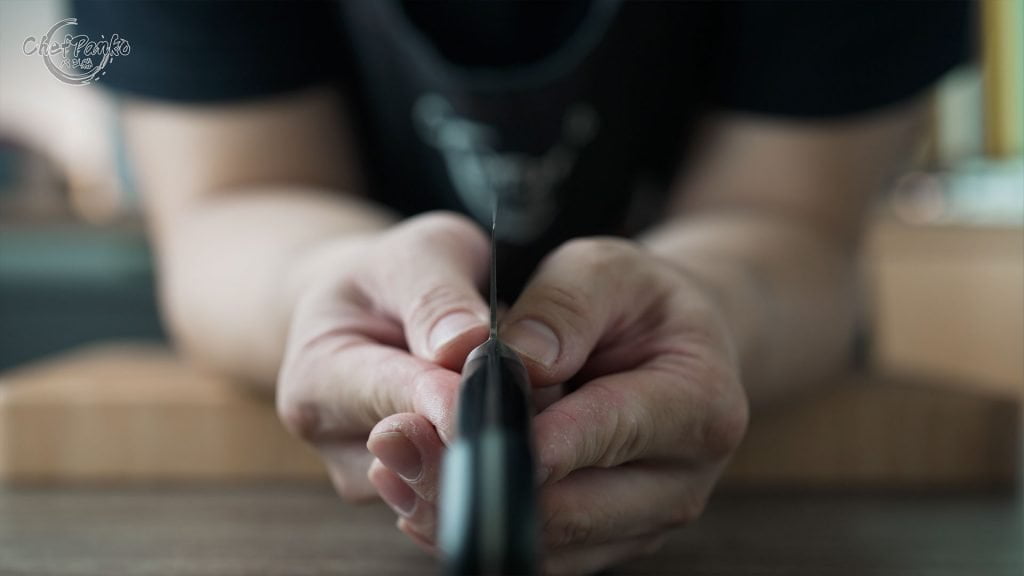
The out-of-the-box edge has a mirror convex grind to increase the durability of the edge. The EU Carbon steel is hardened around 60 on the Rockwell scale. Which will last you around 5 to 6 months with regular honing sessions before needing a whetstone maintenance session if used at home.

Distal spine taper & Fit and Finish
The knife also has a spine distal taper with a thickness of 2.2mm above the heel, 1.8mm in the middle, and 0.9mm at the front (measured 1cm away from the tip).
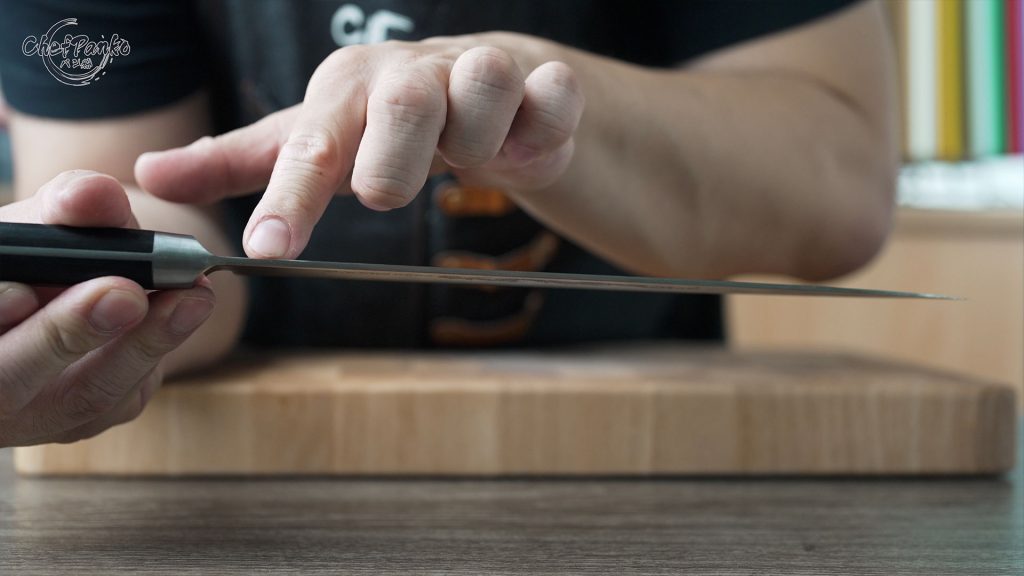
The overall fit and finish are good. The heel is on the sharper side but if you hold the knife correctly at the point of balance, your fingers should not touch the heel at all.
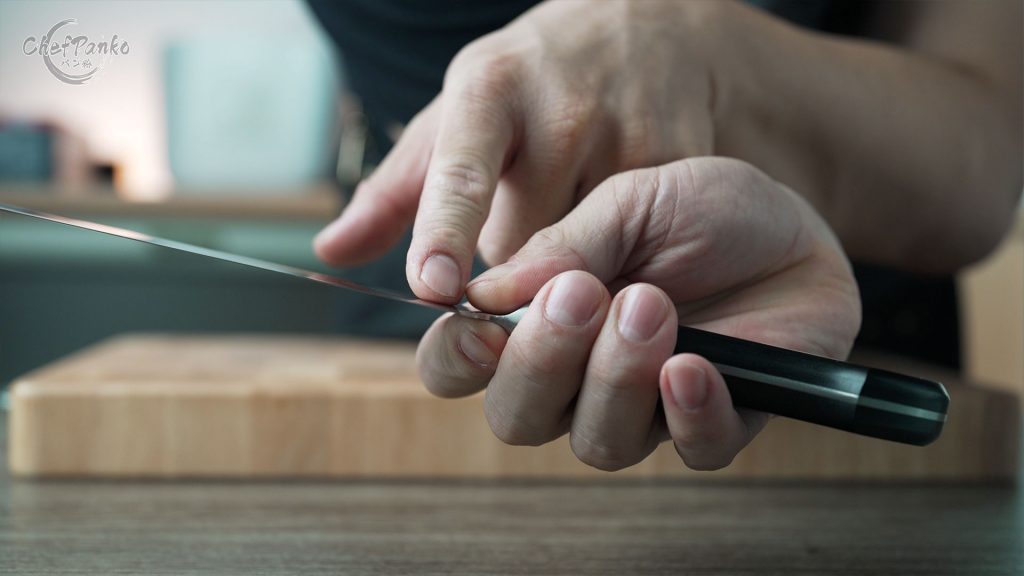
Maintenance & Care
Due to the high-carbon steel, you will notice that getting the edge back on a whetstone is a lot easier and faster. But high carbon means that it is not rust-resistant, therefore it is recommended to keep the knife dry before storing. If this knife is not your daily driver, it is recommended to add a thin layer of mineral oil to prevent the knife from forming rust due to the humidity. Once the blacks fade away from the logo it is recommended to add a thin layer of oil if you did not build a patina layer on the etching. Since the grooves can trap moisture and removing rust from the grooves is not ideal.
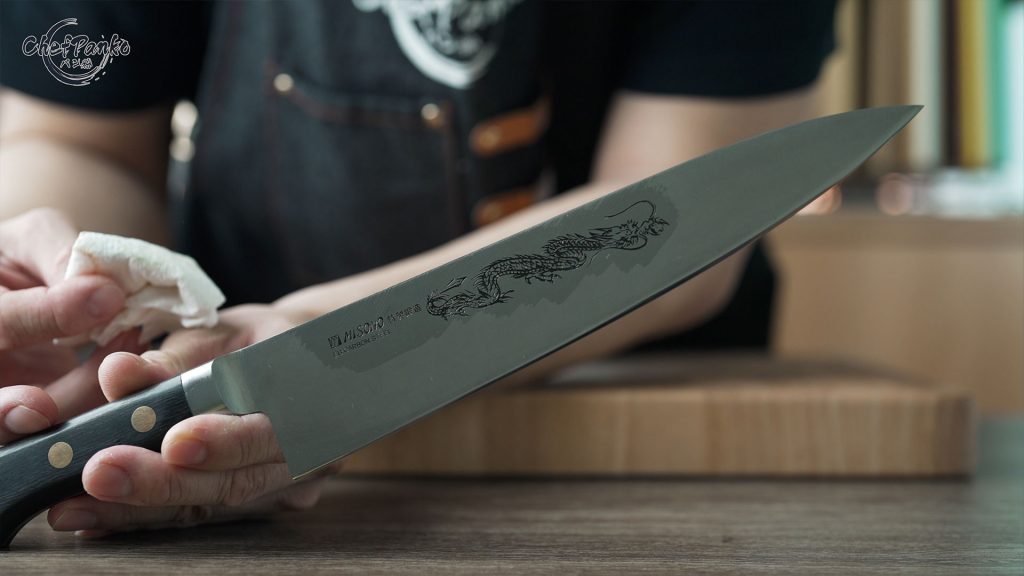
Removing Rust & Cleaning your High Carbon Knife
There are multiple ways to remove rust, I recommend removing the rust with a whetstone. There are a few things you need, one is a stone fixer and a whetstone with a grit around #800 to remove rust. If you want to polish the knife you can use a higher grit stone. Soak the whetstone and use the stone fixer to build up a paste. Use a microfiber cloth to pick up the paste and gently remove the rust spots. You can also use this method with a higher grit stone to keep your knife shiny all the time. Make sure your knife is on a stable surface or use a nonslip mat to prevent the knife from moving.

Key Takeaway & Recommendation
The Misono is a knife that just works without doing anything special or flashy. There is no fancy Damascus pattern, there is no cladding. It does not shine in being the thinnest knife, it does not shine in being the hardest knife. Even if the knife doesn’t do anything special at all, the knife is still one of my favorite knives that I can rely on every single time. The balance of edge-holding, ease of sharpening, and comfort due to the balance point make this knife a perfect workhorse. The Misono High Carbon 240mm Gyuto is a jack of all trades but a master of none.

Recommendations
There is only one thing to consider with the Misono High Carbon Gyuto. If you want a stainless knife then the Misono High Carbon is not for you, since you need to be willing to take care of the High Carbon properties. Luckily Misono offers various Stainless steel versions. Like the Misono Handmade series which is ideal for home use. Misono also has the 440 series and the UX10 series aimed at professionals.
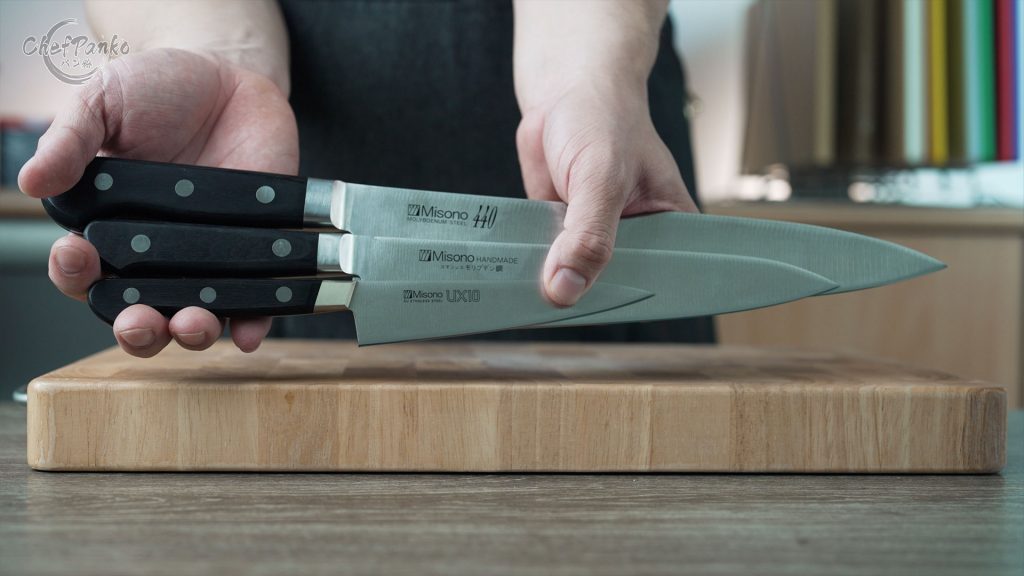
Should You Buy the Misono High Carbon Gyuto?
With the Misono High Carbon Gyuto, you get great value for money if you are right-handed. This is a High Carbon knife that I can recommend to any home cook that is looking for their first carbon knife and any cook at the restaurant. It is a knife that you can rely on for many years in a restaurant setting and probably a lifetime if used at home.
70/30 bevel for left-handed usage?
My advice is to keep the 70/30 bevel if you are right-handed. You can reverse the edge or add a 50/50 bevel but this will decrease the lifespan since the knife will get thicker behind the cutting edge. Therefore I don’t recommend a service that reverses the sharpening angle. If you are left-handed my advice is to ask if the retailer is willing to place a custom left-handed order with Misono.

Warning
Despite the measurements to reinforce the cutting edge the edge is still brittle. Don’t go hammering on bones and don’t twist your blade to break off food.
🛒S H O P:
🔪Misono High Carbon EU Steel Gyuto
All knives used in this article:
🔪Misono Handmade Gyuto
🔪Misono 440
🔪Misono 440 27cm [Proffesional use]🔪Misono UX10 Petty
🔪Misono UX10 Gyuto 21cm
🔪Misono UX10 Gyuto 24cm
▶ If you want to know what knife you should buy you can read the following article ''Choosing your knife''. ▶ On my youtube channel, I have reviewed a lot of different knives. You can watch the playlist by clicking here. ▶ Click here, if you want to search for other kitchen knives on: Amazon. ▶ , if you want to search for other Chinese knives on . ▶ Check out my gear on Kit: https://kit.co/ChefPanko ▶ Check out my recommendation on Amazon: https://www.amazon.com/shop/chefpanko Full Disclosure: If you purchase from these links I get a small commission that goes towards supporting the channel and website. As an Amazon Associate, I earn from qualifying purchases ▶ If you have any questions about Japanese knives made in China or about some of the brands feel free to ask it in the comment section below. Thank you for your support and feedback. ▶ Want to work with me? Please use the contact form by clicking here.

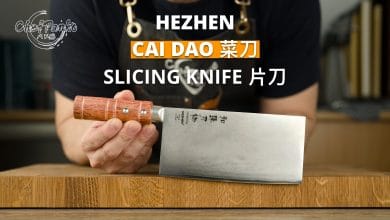
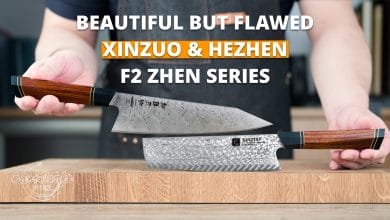
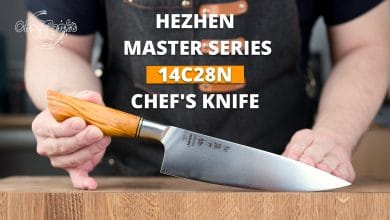
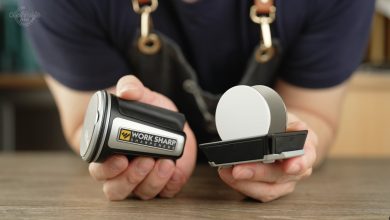
Quick Note: Carbon knives are reactive, which means that the food that gets exposed with the knife that did not build up a patina layer will discolor/turn brown.
Things like Mangoes, onions, etc.
You can stop the reaction by directly dumping your onions in a bowl of water after it has been cut.
Tip: This means if you are a cook doing prep work in a restaurant be aware of this problem! Your chef will not be happy once he sees the brown prep work during service.
You can force a patina or use it on protein.